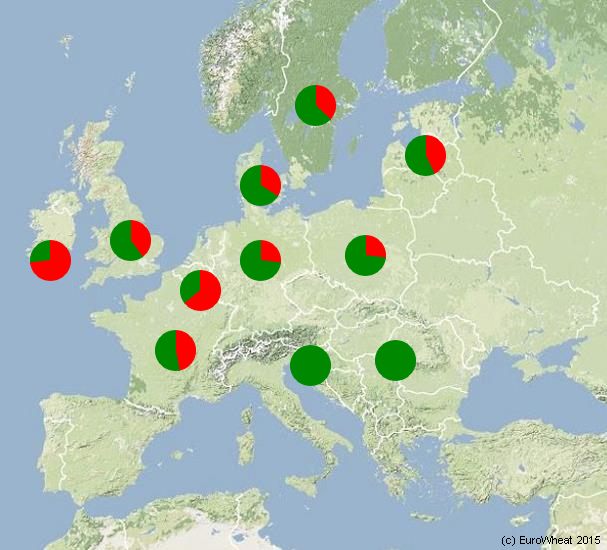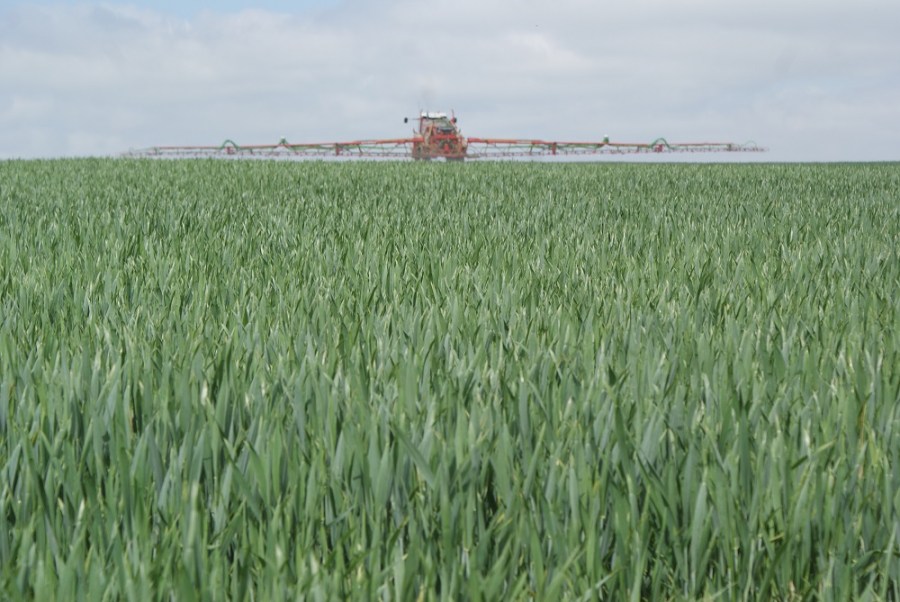As each year passes, septoria resistance to azoles builds, but the pattern across Europe varies. CPM reviews a research programme that’s explored this and assesses the implications for fungicide programmes.
It’s been very inspiring to have a helicopter view of what is around us, not just what we find in our own backyard.
By Tom Allen-Stevens
Be honest – peering over the hedge at what your neighbour’s doing is probably a pastime you enjoy more than you’d care to admit. When it comes to fungicide use, the marvellous reality is that you have a good excuse – your neighbour’s practice and how that’s affecting the population of septoria making its way into your wheat has a direct influence over how you might put your own control programme together.
So imagine how revealing it could be to peer into the fields and the practices of all your European neighbours. That’s exactly what a group of scientists, led by Lise Jørgensen at Aarhus University in Denmark, have done. They’ve spent the past two years comparing notes on the efficacy of different azoles and the effect they’re having on mutations in the septoria population.
Known as the Eurowheat project, funded by BASF, it’s thrown up some interesting results, says Lise Jørgensen. “It’s been very inspiring to have a helicopter view of what is around us, not just what we find in our own backyard. The main finding is the diversity that exists across Europe – it was a real surprise to me.”
Eurowheat extended the work of the Endure network. This was a collaboration of 15 agricultural research, teaching and extension institutes from across Europe with a special interest in Integrated Pest Management (IPM). Funded by the European Commission, the network came together from 2007-2010 to tackle the complexities of helping European farmers meet the challenges of the EU regulatory framework.


The distribution of CYP51 mutations can be found on the Eurowheat website (www.eurowheat.au.uk)
Useful network
“It’s always been a very useful network and we’ve stayed in touch and worked together on a number of projects since,” notes Lise Jørgensen. “It was at a meeting two years ago when we were discussing disease resistance that we came up with a plan to collaborate on some trials.”
The gradual erosion of azole performance and the increasing complexity of the septoria population were common threads in discussions between the partners. “The specific aim of the project was to look at the performance of azole fungicides and to profile this against frequency of CYP51 mutations.” This is the enzyme in Zymoseptoria tritici that azoles target – a mutation here confers a level of resistance for the pathogen.

Is an azole really necessary for a septoria-resistant variety at the beginning and end of the season in a low risk year?
The trials were carried out over two years, with 26 in 2015, across different locations and climate zones, from Ireland to Lithuania, Denmark to Hungary. There were a further 14 trials in 2016. Moderate to susceptible cultivars were chosen and sprayed with fungicides supplied by BASF at flagleaf emergence. In some cases, an early multi-site spray was applied to keep disease at acceptable levels.
The major outcome of the project was the huge variability in how the various azoles performed across Europe. “There were some general trends, however,” she notes.
“Overall, the best control was achieved with epoxiconazole (EPX) or prothioconazole (PTZ) used alone or the co-formulations EPX plus metconazole (MET) and tebuconazole (TEB) plus PTZ.” (see panel on pxx)
That’s largely as growers may expect, she points out. But what the researchers weren’t prepared for was the variation between countries. “Of the single azoles, TEB performed best in Belgium and MET achieved the best results in Ireland and France. TEB also performed fairly well in Ireland but poorly in other countries.”
All treatments resulted in yield benefits. The co-formulations and EPX treatments gave the highest yields, while MET and TEB trailed behind.
The CYP51 values and EC50 values (the dose in a lab required to give half the maximum response) correlate with the results found in the field, reports Lise Jørgensen. “In Belgium, we got good field performance with TEB and a low EC50 value, indicating high levels of sensitivity.
“In some places, you don’t see the nuances any longer, especially where the frequency of CYP51 mutations is high. This seems to be the case in the UK and Ireland to a certain extent, where there were relatively high EC50 values, while Hungary had much lower values.”
Intensity of azole use is the main driver, she says. “There seems to be a gradient as you move across Europe – the further west and north, the more azoles are used, and the greater the frequency of CYP51 mutations. Away from the more intense areas, azoles are performing very differently, and this strengthens the case to retain a diverse range of azole fungicides.”
Gradual shift
The trials in 2016 largely confirmed the results found in 2015, although performance of all azoles dipped slightly, which correlates with the gradual shift in performance over time, she points out. “Co-formulations again outperformed straights. Some mutations are more sensitive to certain azoles than others. By mixing complementary azoles, you hit a wider spectrum of septoria isolates.”
The trials highlight the importance of appropriate dose, she points out. “Growers shouldn’t be too keen to keep the leaf clean. Where mutation frequency is lower, you can apply a lower dose and make fewer applications. In Denmark, for example, good control can be achieved in most years by applying two 40-50% doses at the T2 and T3 timings. Sometimes you may need a T1 azole, but it’s better to increase the dose than the frequency.”
The situation in the UK is somewhat different, notes Dr Neil Paveley of ADAS. “What’s clear from the Eurowheat data, particularly on frequency of mutations and EC50 values, is that the UK septoria population is less sensitive than elsewhere in Europe.”
That fits with AHDB Cereals and Oilseeds fungicide performance data, he notes. “We’re getting lower efficacy than elsewhere, and that’s the result of how wheat has been grown in the UK.
“Historically, growers have chosen high-yielding varieties with poor disease resistance, such as Riband, Consort and KWS Santiago, in an environment very conducive to septoria. So in the UK, we apply three and a half fungicide treatments to wheat crops, while elsewhere in Europe it’s just over two. It’s no surprise, then, we’re selecting very hard for resistant strains.”
Using products with different modes of action is the main resistance-management strategy, emphasis Neil Paveley. “But it is helpful to have a diversity of azoles available so we can use different ones throughout the programme. If regulation removes some azoles from use, we’ll select much harder for resistance against those that remain.”
Previous research has shown that increasing the dose or the number of sprays applied, or splitting the dose, all increase selection for resistance, he continues. “Whereas adding a mixture partner of a different mode of action or alternating can reduce selection.”
When building programmes, he believes it’s essential growers and agronomists look to protect the efficacy of the chemistry they have. “Start with multi-sites and make best use of those. SDHI chemistry is where growers should be most careful. Unlike elsewhere in Europe, the UK allows up to two applications of SDHI in a season, but that should be the exception, rather than normal practice.”
He believes there’s also opportunity to slow the azole decline by cutting down on their frequency of use across the programme. “The question is: where do we have a bit of wriggle room to reduce the selection for resistance? We don’t want to mess with the T2 spray, but if we look at T3, particularly if it’s a septoria-resistant variety in a year with a low fusarium risk, we should ask ourselves whether we really need an azole there.
“At the other end of the season, again if you have a septoria and rust-resistant variety, the multi-site may be enough to protect the crop at the T0 timing, while strobilurins can cope with low levels of rust.”
But frequently these choices revolve around the disease resistance of the variety. “With the exception of Group 3, there are now plenty of varieties on the AHDB Cereals and Oilseeds Recommended List for winter wheat with a 6 or 7 rating for septoria resistance and manageable yellow rust resistance. They are more forgiving varieties in terms of dose, number of treatments and timings,” says Neil Paveley.
While growers need to keep disease under control, he stresses it’s also important not to push the septoria population too hard and select for the more resistant mutations. “We want to avoid building such a sophisticated population that we put the new chemistry under pressure.
“One of the main reasons for this is that in a couple of years’ time, we will hopefully have a new azole, Revysol. It could prove to be a game changer because we still have a septoria population that’s largely sensitive to it. This could take programmes to a stronger position in terms of performance as well as protecting other chemistry. We need Revysol to arrive into a good place in terms of the septoria strains we’re asking it to control, and care taken over fungicide programmes now will help ensure that,” concludes Neil Paveley.
Luck of the Irish keeps septoria at bay
Septoria control has been good for the past two seasons, reckons Irish independent agronomist Eoin Jordan, based in Co Carlow, south west of Dublin. But he feels that’s more down to luck than good management.
“Weather plays such an important part in how septoria is kept under control,” he says. “Growers are now more aware of what needs to be done and focused at getting on at the right time. But with the chemistry we have, while azoles still work well preventatively, if you move into a curative situation, it’s a slippery slope and you’re fighting fires with a very poor fire extinguisher.”
The results of the Eurowheat research aren’t a surprise in terms of the make-up of the population, compared with the rest of Europe. “Irish growers have known for a few years that we’re tackling a difficult septoria population, and that sticking to one azole isn’t the solution. Anecdotally I’ve heard about the performance of MET, and plan to look at this in 2017, but I’d be nervous about relying on TEB at a key spray timing.”
But one change he’s made to help protect the chemistry is to largely remove the azole from the T0 spray timing. “I’ve found that you may have some septoria in the crop by GS32, but an early dose of chlorothalonil (CTL) keeps it at bay. If you apply an azole early, all you do is select out the trickier strains that then move up through the canopy and present a tougher challenge later in the season.”
T1 is when Eoin Jordan likes to “hit septoria hard”, and this will always include CTL onto which he’ll generally build a straight SDHI fungicide. The azole element is usually Gleam (EPX+ MET). “Sometimes we’d go with Adexar (EPX+ fluxapyroxad), but we’ve found a co-formulation of azoles with a straight SDHI works well, and you cannot compromise. We keep rates of azoles at 80-90%, while SDHI should be up at around 80%, too.”
At T2, he’ll use a “good SDHI”, such as Imtrex (fluxapyroxad) with the CTL base. “This is where I’d look to change around on azoles, so perhaps use PTZ, if I’d used Gleam at T1, and/or possibly TEB. I’ve heard about good results with Librax (fluxapyroxad+ MET) which I plan to investigate in 2017.
“But choice of product is really a secondary consideration for us. Far more important is to get the timing right with an application that has a good spread of modes of action.”
By the time the T3 comes along, Eoin Jordan hopes to have a crop with a clean canopy, and fusarium would be the focus. “Generally, a TEB plus PTZ co-form would be the norm. Often we’ll add a strobilurin plus CTL.”
As azole performance has slipped in recent years, he doesn’t regard them as the primary elements of a programme – they’re there to protect the chemistry and bolster performance, but it’s a strategy built around CTL and SDHIs.
“We’re getting good results from SDHIs. That struck home in 2015 – those who compromised rates or left out an SDHI got clean crops, but they ran out of steam and didn’t deliver the high yields achieved by growers who’d made the extra investment.
“It’s only after a season has ended that you can review it and say you could have cut down on an azole here or reduced dose there. But that’s a risky strategy. I’d far rather maintain doses and retain a choice of products in the armoury,” he concludes.




